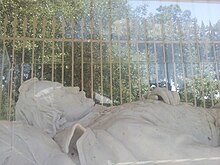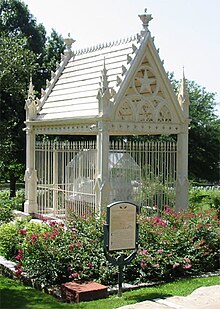Statue of Albert Sidney Johnston (Texas State Cemetery)
| Albert Sidney Johnston | |
|---|---|
 Detail of the statue | |
 | |
| Artist | Elisabet Ney |
| Year | 1903 |
| Medium | Marble sculpture |
| Subject | Albert Sidney Johnston |
| Location | Texas State Cemetery, Austin, Texas, United States |
| 30°15′55″N 97°43′36″W / 30.2652°N 97.7266°W | |
Albert Sidney Johnston is a
History
After his death in 1862,
Ney developed the work between 1902 and 1903 in her Austin studio, Formosa (now the
Design and interpretation

The statue depicts Johnston lying on a
In designing Johnston, Ney aimed for a realistic effect, emphasizing naturalistic details in her composition. The sculpture includes the rough wooden litter and folded cloths on which the dying Johnston is meant to have been carried from the battle.[5]: 119–120 During the work's development, representatives of the Daughters of the Confederacy pressed Ney to include more symbolic or allegorical elements, but Ney refused, insisting upon a scene which could in fact have occurred on the Shiloh battlefield.[4] She did, however, intend the broken flagstaff to poetically suggest that the Confederacy's hopes of victory had been destroyed by Johnston's death.[7]: 205
Ney designed the statue's enclosure with open ironwork bars and railings so that the tomb and statue would be visible from all sides without visitors having to enter the mausoleum. She included Gothic elements (such as
References
- ^ ISBN 9780292760363. Retrieved October 5, 2017.
- ^ a b "Albert Sidney Johnston". Texas State Cemetery. Archived from the original on October 6, 2017. Retrieved October 5, 2017.
- ^ a b Cartwright, Gary (May 2008). "Remains of the Day". Texas Monthly. Archived from the original on October 6, 2017. Retrieved October 5, 2017.
- ^ a b Martinello, Marian L.; Cutrer, Emily; Lowman, Al (1983). Elisabet Ney: Artist, Woman, Texan. University of Texas Institute of Texan Cultures at San Antonio. p. 29. Archived from the original on October 5, 2017. Retrieved October 2, 2017.
- ^ a b c Taylor, Bride Neill (1916). Elisabet Ney, Sculptor. Devin-Adair Publishing Company. Retrieved October 2, 2017.
- ^ "Elisabet Ney Museum". City of Austin. April 9, 2015. Archived from the original on January 10, 2018. Retrieved October 2, 2017.
- ^ ISBN 9781623494247.
External links
 Media related to Albert Sidney Johnston gravesite at Wikimedia Commons
Media related to Albert Sidney Johnston gravesite at Wikimedia Commons
